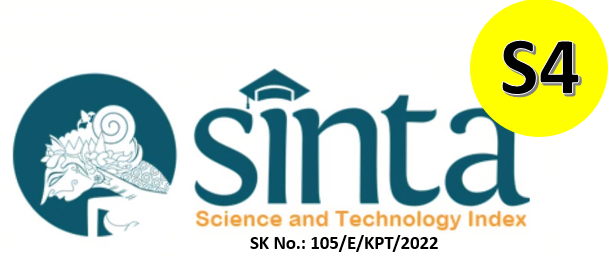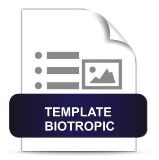Potensi Fungi Rizosfer Tanaman Damar (Agathis dammara) Sebagai Agensia Biokontrol Fusarium oxysporum
DOI:
https://doi.org/10.29080/biotropic.v8i1.2066Keywords:
antagonist, inhibitory ability, Fusarium, pathogen, rhizosphereAbstract
Plant diseases become one of the dangerous threats to agriculture. Fusarium oxysporum is one of pathogen that attack many agricultural plants. The spread of plant pathogens must be controlled. One of the way to control plant pathogens is to use biological control methods by utilizing biocontrol agents using antagonistic fungi to control F. oxysporum. Antagonistic fungi can be found in various habitats such as rhizosphere soil that contains a lot of exudate released by the roots so that the area is rich in organic compounds. Sampling was carried out in the rhizosphere soil of Damar plants from the Baturraden Botanical Garden. Research on antagonistic fungi from the plant rhizosphere needs further exploration. Therefore, this study was conducted to obtain isolates of rhizosphere fungi that have potential as antagonists against F. oxysporum. This research was carried out with method stages ranging from sampling, isolation, characterization and identification to antagonism tests. The isolation results stated that five different fungi were found from the rhizosphere of the Damar plant. The fungi found were then tested for antagonistic ability against F. oxysporum and it was found that R5 isolate had the best ability to inhibit the growth of F. oxysporum with an inhibitory percentage value of 72.06%. This ability can be new information to be able to develop further about the potential of large plant rhizosphere fungi in their inhibition against plant pathogens.
Downloads
References
Adnan, M., Islam, W., Shabbir, A., Khan, K. A., Ghramh, H. A., Huang, Z., Chen, H. Y. H., & Lu, G. (2019). Plant defense against fungal pathogens by antagonistic fungi with Trichoderma in focus. Microbial Pathogenesis, 129, 7–18. https://doi.org/10.1016/j.micpath.2019.01.042
Ainbikapathy, V., Panneerselvam, A., & Saravanamuthu·, R. (2002). ANTAGONISTIC EFFECT OF SOIL FUNGI TO FUSARIUM SOLANI APPEL AND WLLENWEHER. In Agric. Sci. Digest (Vol. 22, Issue 1).
Alwathnani, H. A., Perveen, K., Tahmaz, R., & Alhaqbani, S. (2012). Evaluation of biological control potential of locally isolated antagonist fungi against Fusarium oxysporum under in vitro and pot conditions. African Journal of Microbiology Research, 6(2). https://doi.org/10.5897/ajmr11.1367
Dubey, S. C., Suresh, M., & Singh, B. (2007). Evaluation of Trichoderma species against Fusarium oxysporum f. sp. ciceris for integrated management of chickpea wilt. Biological Control, 40(1), 118–127. https://doi.org/10.1016/j.biocontrol.2006.06.006
Ghanbarzadeh, B., Safaie, N., & Goltapeh, E. M. (2014). Antagonistic activity and hyphal interactions of Trichoderma spp. against Fusarium proliferatum and F. oxysporum in vitro. Archives Of Phytopathology And Plant Protection, 47(16), 1979–1987. https://doi.org/10.1080/03235408.2013.864506
Gupta, S., Sharma, D., & Gupta, M. (2017). Climate Change Impact on Plant Diseases. In Microbes for Climate Resilient Agriculture (pp. 41–56). John Wiley & Sons, Inc. https://doi.org/10.1002/9781119276050.ch3
Hartati, S., Yuniah Nur, R., Daradjat Natawigena, W., & Suganda, T. (2022). Potency of Yeasts Isolated from Shallot Rhizosphere to Control Basal Rot (Fusarium oxysporum f.sp. cepae) Disease on Shallot. Cropsaver : Journal of Plant Protection, 5(1), 23–32.
Ilyas, M. (2007). Isolasi dan identifikasi mikoflora kapang pada sampel serasah daun tumbuhan di kawasan Gunung Lawu, Surakarta, Jawa Tengah. Biodiversitas, 8(2), 105–110.
Islam, W. (2018). Plant Disease Epidemiology: Disease Triangle and Forecasting Mechanisms In Highlights. Hosts & Viruses, 5. https://doi.org/10.17582/journal.hv/2018/5.1.7.11
Kramadibrata, K. (2013). Keanekaragaman Glomeromycota di Kebun Raya Baturaden dan Sekitarnya di Gunung Slamet. Berita Biologi, 12(2), 217–222.
Küçük, Ç., & Kivanç, M. (2004). In Vitro Antifungal Activity of Strains of Trichoderma harzianum In Vitro Antifungal Activity of Strains of Trichoderma harzianum. Turkish Journal of Biology, 28(2), 111–115.
Kumar, P., Misra, A. K., Modi, D. R., & Gupta, V. K. (2012). Biocontrol potential of Trichoderma species against mango malformation pathogens. Archives Of Phytopathology And Plant Protection, 45(10), 1237–1245. https://doi.org/10.1080/03235408.2012.664711
Lynch, J. M., Brimecombe, M. J., & Leij, F. A. (2001). Rhizosphere. In eLS. Wiley. https://doi.org/10.1038/npg.els.0000403
Ma, L.-J., Geiser, D. M., Proctor, R. H., Rooney, A. P., O’Donnell, K., Trail, F., Gardiner, D. M., Manners, J. M., & Kazan, K. (2013). Fusarium Pathogenomics. Annual Review of Microbiology, 67(1), 399–416. https://doi.org/10.1146/annurev-micro-092412-155650
Mohiddin, F., Bashir, I., Padder, S. A., & Hamid, B. (2017). Evaluation of different substrates for mass multiplication of Trichoderma species. Journal of Pharmacognosy and Phytochemistry, 6(6), 563–569.
Murali, M., Naziya, B., Ansari, M. A., Alomary, M. N., AlYahya, S., Almatroudi, A., Thriveni, M. C., Gowtham, H. G., Singh, S. B., Aiyaz, M., Kalegowda, N., Lakshmidevi, N., & Amruthesh, K. N. (2021). Bioprospecting of Rhizosphere-Resident Fungi: Their Role and Importance in Sustainable Agriculture. Journal of Fungi, 7(4), 314. https://doi.org/10.3390/jof7040314
Ommati, F., & Zaker, M. (2012). In vitro and greenhouse evaluations of Trichoderma isolates for biological control of potato wilt disease ( Fusarium solani ). Archives Of Phytopathology And Plant Protection, 45(14), 1715–1723. https://doi.org/10.1080/03235408.2012.702467
Popiel, D., Kwasna, H., Chelkowski, J., Stepien, L., & Laskowska, M. (2008). Impact of selected antagonistic fungi on Fusarium species-toxigenic cereal pathogens. Acta Mycologica, 43(1), 29–40.
Rajeswari, P., & Kannabran, B. (2011). In Vitro Effects of Antagonistic Microorganisms on Fusarium oxysporum [Schlecht. Emend. Synd & Hans] Infecting Arachis hypogaea L. Journal of Phytology, 3, 83–85.
Sari, N. (2020). Review of Endophytic Fungi as Biocontrol Agents Against Plant Pathogen. Gontor AGROTECH Science Journal, 6(1), 55. https://doi.org/10.21111/agrotech.v6i1.3734
Schöneberg, A., Musa, T., Voegele, R. T., & Vogelgsang, S. (2015). The potential of antagonistic fungi for control of Fusarium graminearum and Fusarium crookwellense varies depending on the experimental approach. Journal of Applied Microbiology, 118(5), 1165–1179. https://doi.org/10.1111/jam.12775
Shahid, M., Srivastava, M., Sharma, A., Kumar, V., Pandey, S., & Singh, A. (2013). Morphological, Molecular Identification and SSR Marker Analysis of a Potential Strain of Trichoderma/Hypocrea for Production of a Bioformulation. Journal of Plant Pathology & Microbiology, 04(10). https://doi.org/10.4172/2157-7471.1000204
Singh, R., Singh, B. K., Upadhyay, R. S., Rai, B., & Lee, Y. S. (2002). Biological Control of Fusarium Wilt Disease of Pigeonpea. The Plant Pathology Journal, 18(5), 279–283. https://doi.org/https://doi.org/10.5423/PPJ.2002.18.5.279
Srinon, W., Chuncheen, K., Jirattiwarutkul, K., Soytong, K., & Kanokmedhakul, S. (2006). Efficacies of antagonistic fungi against Fusarium wilt disease of cucumber and tomato and the assay of its enzyme activity. In Journal of Agricultural Technology and Kanokmedhakul, S.
Suárez-Estrella, F., Vargas-García, C., López, M. J., Capel, C., & Moreno, J. (2007). Antagonistic activity of bacteria and fungi from horticultural compost against Fusarium oxysporum f. sp. melonis. Crop Protection, 26(1), 46–53. https://doi.org/10.1016/j.cropro.2006.04.003
Verma, M., Brar, S. K., Tyagi, R. D., Surampalli, R. Y., & Valéro, J. R. (2007). Antagonistic fungi, Trichoderma spp.: Panoply of biological control. Biochemical Engineering Journal, 37(1), 1–20. https://doi.org/10.1016/j.bej.2007.05.012
Woloshuk, C. P., & Shim, W. B. (2013). Aflatoxins, fumonisins, and trichothecenes: A convergence of knowledge. In FEMS Microbiology Reviews (Vol. 37, Issue 1, pp. 94–109). https://doi.org/10.1111/1574-6976.12009
Zuhria, S. A., Djauhari, S., & Muhibuddin, A. (2016). Exploration and Antagonistic Test of Endophytic Fungi from Soybean (Glycine max L. Merr) With Different Resistance to Sclerotium rolfsii. The Journal of Experimental Life Sciences, 6(2), 101–105. https://doi.org/10.21776/ub.jels.2016.006.02.08
Downloads
Published
How to Cite
Issue
Section
License
Copyright (c) 2024 Galang Anahatta Hidayat, Arif Rahman Hikam, Yuriza Eshananda, Brenda Liestyaning Adi, Tyas Wanda Septiani

This work is licensed under a Creative Commons Attribution-NonCommercial-ShareAlike 4.0 International License.













